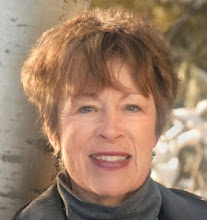What could be more exciting than firecrackers on the 4th of July? For me, summer programs centered around the remarkable women of New Mexico. This past July the Taos-based group Izcalli In Nanantzin Danza Azteca, under the direction of Capitana Tanya Ocañas y Vigil, ended their feast day celebration on a Saturday afternoon with a dance in Aztec regalia. The festivities which included a velacíon or prayer vigil and a procession to the San Francisco de Asís church, honored Señor Santiago de Los Cuatro Vientos (St. James of the Four Winds). That weekend celebrations of the biblical Santiago and Santa Ana (St. James and St. Anne) at the annual Taos fiestas took place on the Plaza. The weekend began with a Fiesta mass followed by a line-up of Spanish music and dance that included groups of Taos women performers like Catalina Río Fernandez and Flamenco Nuevo Mexico, and the Audrey Davis Trio.
 |
Colorful dancers along State Road 68 in Ranchos de Taos. Photo by Rick Romancito, © 2011* |
Earlier, in June, the final of four exhibitions opened at Santa Fe’s New Mexico History Museum. All include stories of women. Since its opening in 2009, the New Mexico History Museum has featured stories of men, women and children as part of a conscious effort to broaden the telling of history. This summer’s exhibits, according to museum director Frances Levine, focus “squarely on the contributions made by women that don’t begin and end with popular Western stereotypes.” The exhibition Home Lands: How Women Made the West, presents such well-known New Mexican artists as Pueblo potter Maria Martinez, painters Pablita Velarde and Georgia O’Keeffe, and photographer Laura Gilpin. Contemporary New Mexico artists include New Mexican santera (carver of saints) Gloria Lopez Cordova; Santa Clara Pueblo artists Tammy Garcia and Nora Naranjo Morse. To complement Home Lands, Albuquerque-based poet and playwright Joy Harjo was commissioned to create a video piece inspired by a historic narrative of slavery and interracial marriage in 19th century New Mexico.
 |
Dorothea Begay. Photo by Ann Bromberg, © 2011** |
A traditional Navajo sheep rancher in Canoncity, Begay told author Sharon Niederman in 1996, “We need to bring back our livestock. To learn to survive off that; to learn to work and farm. We must care for the community together.”
A second exhibition, Ranch Women of New Mexico, documents the lives of 11 women who have “cow-girled” or owned ranches in the state over the past 50 years. The text by Raton author Sharon Niederman and photos by Albuquerque photographer Ann Bromberg bring to life women's dynamic contributions to the environment, their multicultural families, and their economic survival in a "boots on the ground" way of life.
 |
Mary B. Davis. Photo by Ann Bromberg, © 2011 |
Daughter-in-law of legendary New Mexico rancher Linda Davis, Mary B. Davis shows what she's made of as manager of the horse breeding operation of the Crow Creek Division of the CS Ranch.
The staff at the New Mexico History Museum designed a summer program to augment these exhibitions. Coming up this month: “Homespun: Northern New Mexico Spinning and Weaving Techniques,” demonstrations by the Española Valley Fiber Arts Center, and a lecture “Through Her Eyes: An American Indian Woman’s Perspective.” Due to travels to interview some remarkable women in Wallowa County, OR, I missed Dr. Tey Diana Rebolledo’s lecture “Fabiola Cabeza de Baca and The Good Life.” A native of Las Vegas, NM, teacher and writer Fabiola Cabeza de Baca “elevated both the art and science of homemaking from the Depression forward, blending traditional practices with modern-day conveniences. Beginning in the 1950s, her expertise went global when she started home-economics programs in Central and South America for the United Nations and became a trainer for the Peace Corps.” Her story is included in the Home Lands exhibition.
My interest in Fabiola Cabeza de Baca stems from her work in the 1940s with the County Extension Service in Taos. My friend Corina Santistevan recalled her teaching local women to can both meats and vegetables with a huge pressure canner that was brought for use by the community. I will be profiling Fabiola Cabeza de Baca later this month.
Just today Judi Jordan and I talked about Mabel visiting people and places throughout the Taos Valley and in other places throughout New Mexico. Oh how Mabel would have enjoyed visiting with these interesting women!
Adios for now,
Liz* Courtesy of Rick Romancito, Tempo editor, The Taos News
* Courtesy of the Photo Archives at the Palace of the Governors/New Mexico History Museum, DCA, Ann Bromberg Collection HP.2008.31.

Wonderful post!
ReplyDelete